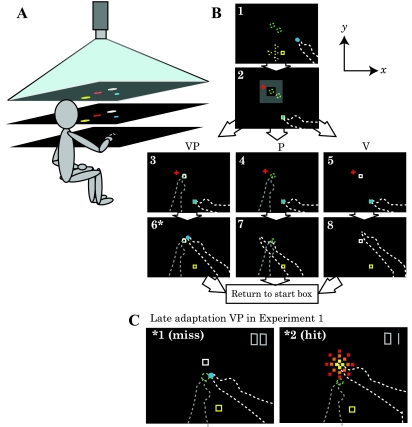Fig. 3.
Experimental setup for experiments 1 and 2. A: the subject looked down into a horizontal mirror (middle) and saw targets and cursors indicating hand position reflected from a horizontal rear projection screen (top). The (dominant) reaching hand rested on a hard acrylic reaching surface (bottom) below the mirror. The (nondominant) target hand remained below the reaching surface at all times. The mirror was positioned midway between screen and reaching surface, such that images in the mirror appeared to be in the plane of the reaching surface. Not pictured: black drapes that obscured the subject's vision of his/her arms and the room outside the apparatus. B: timeline of a single reach in the baseline block and bird's eye view of the display. Dashed lines were not visible to the subject. The total display area was 75 × 100 cm. Schematic is not shown to scale. V, visual target; P, proprioception target; VP, combination of V and P targets. Screen 1: subjects placed their reaching finger (white dashed line) in the yellow start box, which appeared in one of five possible positions (yellow dashed squares; the central position was 20 mm from each of the other positions), with the aid of an 8-mml:diameter blue cursor indicating reaching finger position [veridical to minimize proprioceptive drift between reaches (Wann and Ibrahim 1992)]. Screen 2: a red fixation cross appeared in a random location within an invisible zone (gray), and subjects were instructed to fixate on it for the duration of the reach. Screens 3–5: subjects positioned their target finger (dashed gray line) as instructed, on one of the two tactile markers stuck to the bottom of the reaching surface ∼40 mm apart (green dashed circles) for a P or VP target or down in their lap for a V target, which appeared as a white box in one of the two possible target locations. For VP reaches, the V target was projected on the P target during the baseline block but was gradually offset in the y direction during the adaptation block. Once both hands were correctly positioned, subjects reached toward the target, with the cursor disappearing at movement initiation. Movement speed was not restricted, and subjects were permitted to make adjustments. Screens 6–8: when the reaching finger had not moved more than 1 mm for 2 consecutive seconds, the endpoint position was recorded and the red fixation cross disappeared. In experiment 2, subjects were immediately instructed to lower their target hand to rest in their lap and return the reaching finger to the start box. In experiment 1 only, endpoint visual feedback (blue dot) was displayed for 2 s at the movement endpoint location after reaches to VP targets. After this, subjects were instructed to lower their target hand and return the reaching finger to the start box. C: bird's eye view of an unsuccessful (screen 1) and successful (screen 2) reach to a late adaptation VP target in experiment 1. The illustration is to scale. The V component (white box) of VP targets was gradually displaced up to 70 mm away from the P component (green dashed circle) in the positive y direction. Subjects were not aware of this manipulation, but reaching endpoints close to the V component (screen 2) counted as a hit: subjects viewed an animated explosion, heard sound effects, and were awarded a point (top right corner). Reaching endpoints farther than 10 mm from the V component (screen 1) resulted in a negative sound effect and no point was awarded. In other words, the visual estimate of target hand position had to be regarded as the “good” estimate (and proprioception the “bad” estimate) to succeed in experiment 1. In experiment 2, no endpoint visual feedback was given (no blue dot, no explosions, and no points awarded). *Endpoint visual feedback was given in experiment 1 only and only for VP targets.

